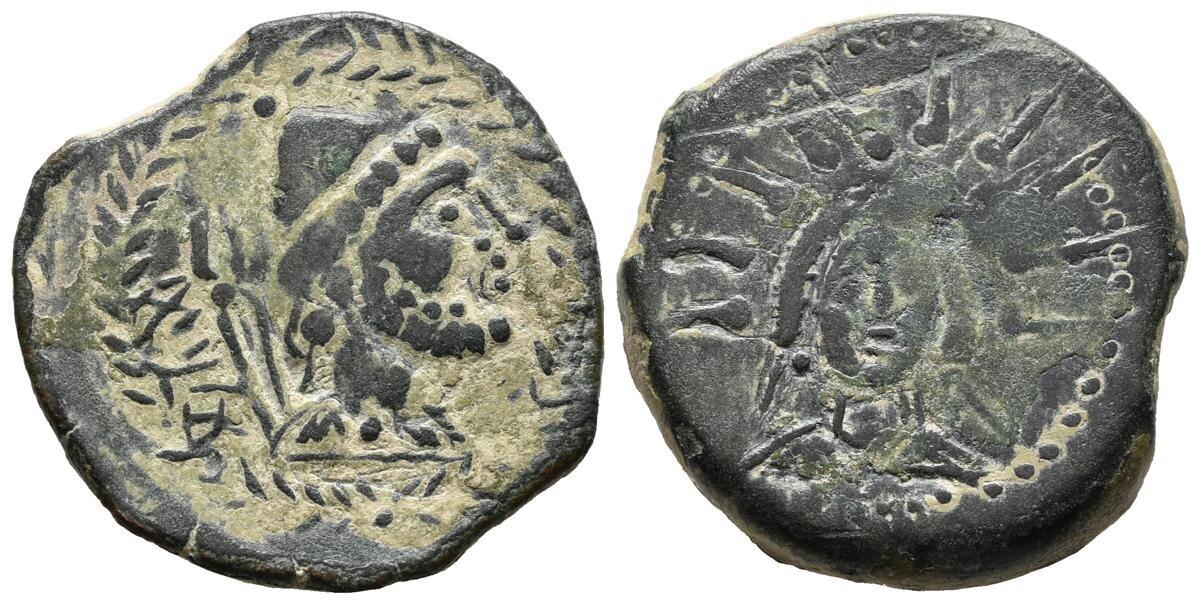S 1668 - Malaca, bronze, units (175-100 BCE)
From SILVER
175 BCE - 100 BCE Bronze
Description
| ObverseInscription or printing placed on the obverse.: | (Punic).Head of Vulcan to the right, pincers behind and type A Punic legend |
| ReverseInscription or printing placed on the reverse.: | Head of Helios from the front |
Mint and issuing power
| MintIdentifies the place of manufacture or issue of a numismatic object.: | Malaca | Ancient regionAncient region.: | Hispania Ulterior | Modern countryModern country: Spain | AuthorityIdentifies the issuing power. The authority can be "pretended" when the name or the portrait of X is on the coin but he/she was not the issuing power. It can also be "uncertain" when there is no mention of X on the coin but he/she was the issuing power according to the historical sources: |
Chronology
| FromIdentifies the initial date in a range assigned in a numismatic context. | 175 BCE | toIdentifies the final date in a range assigned in a numismatic context.. | 100 BCE | PeriodTime period of the numismatic object.: Hellenistic 323-30 BC |
Physical description
| MetalThe physical material (usually metal) from which an object is made.: | Bronze |
Median weightMedian of the weights of numismatic objects (in grams). in grams | 10.80 | DenominationTerm indicating the value of a numismatic object. Examples: tetradrachm, chalkous, denarius.: | unit |
StandardStandard.: |
Image

S 1668 - Malaca, bronze, units (175-50 BCE).jpg [1]
References
| Die study referencePublication of the study: | Campo - Mora-Serrano 19951Campo - Mora-Serrano 1995, p. 227-257, n° 20-165 (Period II) | ||
| Coin series referenceReference to coin series study: | |||
Obverse dies distribution
| FrequencyFrequency of specimen in distribution. ᵖ | Number of obversesNumber of obverse dies. ᵖ (o) | % (o) | Number of coinsNumber of coins. (n) | % (n) | Die nameName(s) of the die(s). |
| 3 | 2 | 6.25 | 6 | 1.02 | 10, 31 |
| 4 | 3 | 9.38 | 12 | 2.03 | 6, 22, 24 |
| 7 | 3 | 9.38 | 21 | 3.55 | 2, 18, 30 |
| 10 | 2 | 6.25 | 20 | 3.38 | 19, 28 |
| 11 | 2 | 6.25 | 22 | 3.72 | 25, 32 |
| 13 | 1 | 3.13 | 13 | 2.2 | 12 |
| 14 | 2 | 6.25 | 28 | 4.74 | 4, 7 |
| 15 | 1 | 3.13 | 15 | 2.54 | 14 |
| 16 | 1 | 3.13 | 16 | 2.71 | 9 |
| 17 | 1 | 3.13 | 17 | 2.88 | 23 |
| 18 | 1 | 3.13 | 18 | 3.05 | 27 |
| 19 | 2 | 6.25 | 38 | 6.43 | 5, 20 |
| 21 | 1 | 3.13 | 21 | 3.55 | 21 |
| 22 | 1 | 3.13 | 22 | 3.72 | 29 |
| 24 | 1 | 3.13 | 24 | 4.06 | 1 |
| 25 | 1 | 3.13 | 25 | 4.23 | 11 |
| 26 | 1 | 3.13 | 26 | 4.4 | 26 |
| 29 | 1 | 3.13 | 29 | 4.91 | 8 |
| 35 | 2 | 6.25 | 70 | 11.84 | 15, 16 |
| 37 | 1 | 3.13 | 37 | 6.26 | 17 |
| 43 | 1 | 3.13 | 43 | 7.28 | 13 |
| 68 | 1 | 3.13 | 68 | 11.51 | 3 |
| Total | 32 of 32 | 100.08 | 591 of 591 | 100.01 |
Reverse dies distribution
no distribution is available
Quantification
| Number of obversesNumber of obverse dies. ᵖ (o) | 32 | Number of singletons (o1)The number of singleton coins. ᵖ | 0 |
| Number of reverse diesNumber of reverse dies. (r) | 110 | Number of coinsNumber of coins. (n) | 591 |
| Coins per obverse dieNumber of coins per obverse die. (n/o) | 18.47 | Coins per reverse dieNumber of coins per reverse die. (n/r) | 5.37 |
| Reverse per obverse ratioRatio of obverse dies divided by reverse dies. (r/o) | 3.44 | Percentage of singletons (o1)number of coins (n) divided by the number of singletons (o1) ᵖ | 0 % |
| Original number of dies (O) (Carter 1983 formula)The estimation of the number of coins according to Carter 1983 ᵖ | 31.27 | Coins struck if 20,000 as average productivity per dieCoins made if the average productivity for obverses (according to Carter) is 20,000. ᵖ | 625,400 |
| Original number of dies (O) (Esty 2011 formula)The estimation of the number of coins according to the singleton formula in Esty 2011 ᵖ (O) | 33.83 | Survival rate if 20,000 as average productivity per dieSurvival rate if average productivity is 20,000. ᵖ | 0.00094 |
| Coverage (o = % of O) (Esty 1984 formula)Esty 1984 - coverage (% of O) ᵖ (o = % of O) | 100% | Die productivity if survival rate 1/2,000Average productivity if survival rate is 1/2,000. ᵖ | 37,799.81 |
| Weight of silver (in kg) if 20,000 coins per die (O = Carter formula)Carter 1983 * Median weight * 20000 (*10 if gold or electrum) ᵖ | n.a. | Die productivity if survival rate 1/5,000Average productivity if survival rate is 1/5,000. ᵖ | 94,499.52 |
Remarks
References
- ^ Campo, Marta - Mora-Serrano, Bartolomé (1995), Las monedas de Malaca, Madrid, Museo Casa de la Moneda, 341 p.